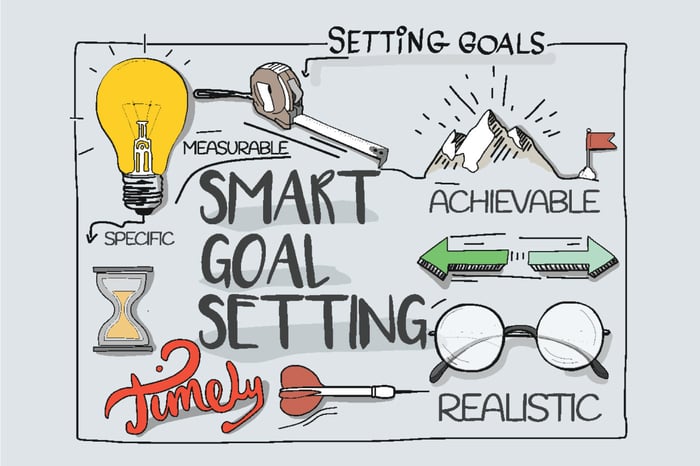
Every manager knows this: team members almost always start projects with enthusiasm.
At the other end of the journey, the home stretch of any assignment brings with it a sense of accomplishment. The team is pumped and morale is high, and all that energy helps them sprint past the finish line.
How can we leverage this momentum for everyday work? How do we keep team members motivated when they’re halfway through a complex project and the end is nowhere in sight?
We do this by working SMARTer, not harder. Today, we outline strategies for setting team targets guaranteed to set your people up for success.
When it comes to setting SMART goals...
Being specific is not enough, be specialized
“Are our goals specialized enough to achieve the desired ends and challenge my team?”
Without a clear sense of what it is that you want your team to achieve, it will be difficult to quantify ”success.” Consider setting goals that provide value not only to the organization but also to the team members working to achieve them. Clearly address the ‘what’ to be achieved, the ‘how’ and the ‘when’ for each goal.
We recommend addressing the ‘why’ too. Show that achieving these goals will bring value to the organization and ‘in what ways’ team members will grow from achieving them.
Which of the following goals is more likely to get the results we seek?
“Let’s hit the $20K earnings mark by June!”
OR
“Let’s achieve $10K in new business from our remote sales teams in the U.K by the close of the first Fiscal quarter of 2019, through leads gained from targeted Facebook and Google ads with another $10K in referrals from our office staff here in the Mid Atlantic working the CRM! Also, we’re going to have a friendly competition between the Mid Atlantic team and the U.K. team: the team that reaches their $10K goal first gets to split a $2K bonus!”
The first goal is vague, stating our desire with no sense of direction. The second goal, however, provides more detail—how those financial goals will be achieved, by which teams, and through which channels. It also provides an incentive for team members to achieve the goal and promotes team creativity. The second goal is specific and specialized in such a way that both the organization and the team benefit from accomplishing it.
Be measurable to team members as well
“Can your success be quantified? What does it look like?”
How will you know if you’re headed in that direction? What does ‘done’ look like? Craft your goals to have a clearly-defined point of success that allows you to say, “We have accomplished this specific thing we set out to achieve.” Once you establish the end goal, determine what metrics will be used to measure success.
As a manager, you should also identify areas of opportunity for the growth of each team member, and connect that to their measurable goals. By making it measurable, you give them the opportunity to quantify their own improvement too—making SMART goals for teamwork and elevating each individual along the way.
Be attainable
“Is your team qualified to achieve the goals set? Do they need more resources?”
Determine what it will take to achieve success… and if that isn’t practical, then figure out how to modify your goals in such a way that the ends are attainable. Perhaps some talent needs to be outsourced so your core team can focus on their areas of expertise?
Be relevant
“How does the goal fit into the bigger picture of the organization’s mission?”
Ensure that each goal that is relevant to the greater mission of the organization. This helps team members stay grounded in their purpose and affirms the importance of their individual contributions.
Be time-based
“Can your goal be achieved in a realistic timeframe?”
Once you define a goal, split it into smaller milestones with their own deadlines. This stops team members from becoming overwhelmed by ambitious goals. It is less intimidating to focus on one small component of a project at a time. Your focus should be on establishing a sense of urgency without creating anxiety.
Make this work for you by building out OKRs and "chunking" tasks into individual initiatives that lend themselves toward the KR at hand. Use project management tools like Asana or Jira to track progress and establish fluid handoff processes. Utilize smart tools like ToDo's or reminders to stay on deadline.
Done right, SMART goals motivate team members to come together and achieve a task important to the greater organization, while also ensuring that they have the resources needed to get the job done. However, setting your team up for success must come from a place of empowerment.
If you are a manager implementing SMART goals...
Make yourself available
Your team should feel that you are an integral part of their support system. Ensure communication lines are open, meet regularly with team members to evaluate their progress and make sure that they are headed in the right direction.
Be open to criticism
Solicit feedback from team members throughout the process. Success can only happen when everyone is comfortable communicating and dialogue is honest and open. As a manager, you should be willing to make adjustments based on your team’s feedback.
Apply the lessons learned
Once a goal is achieved, sit down with your team and discuss what worked, what didn’t, and what can be done differently the next time. Were milestones established at the right points throughout the process? Were enough additional resources pulled in to accomplish what team members could not? Think about how things might run more smoothly the second time around.
Focus on the process… not just the outcome
One trap managers fall into when setting goals using the SMART framework is giving too much attention to the end result. Yes, focusing on the outcome is important, but the process to achieve it should be qualitatively assessed with feedback from the team. A Machiavellian approach to crushing goals often leaves employees, well, crushed. That’s neither good for morale nor for fostering a healthy team culture. Knowing how to implement SMART goals—and enjoy the process—is the secret to a successful team.
Have you implemented SMART goals for your team? What lessons have you learned from your experience? Do you have any tips for new managers settings goals for their teams? Let us know.







